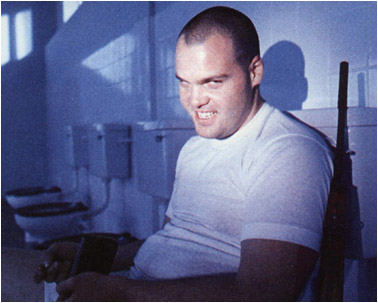Now Playing: Fox on RD Records
Topic: F
Although a very strong period for cinema, the early 1970s had its share of smaller movies that time has allowed to fall through the cracks of public amnesia. Despite its forgotten status today, FIGURES IN A LANDSCAPE (1970) displays no shortage of strong 'names', directed as it was by the renowned Joseph Losey and with the powerful screen presences of Robert Shaw and Malcom McDowell in a double protagonist set-up.
The movie could be construed as an action feature with certain parallels to Stanley Kramer's The Defiant Ones (1958) and Steven Spielberg's Duel (1971), as the swiftly moving camera follows the two men on a seemingly endless escape through an unidentified country in what looks like Northwestern South America. People are killed, including an entire army garrison and some unlucky passers-by, as 'Mac' (Shaw) and 'Ansell' (McDowell) fight their way towards survival on the other side of a snowy mountain range. Always on their heels is an ominous black helicopter, and soon also a large army posse. The two leads walk, run, crawl, limp, swim and climb their way towards freedom, while eating canned food and bickering about their next move. The ending needn't be revealed here as it's a movie worth seeing, which can be discussed without this knowledge.
However, I believe better milage is drawn from Figures In A Landscape if one approaches it as a character study of two strong-willed individuals in duress rather than a thriller. There is a certain undertone of experimental '60s theatre in the script (written by Shaw from a novel, incidentally), even with the abundance of beautiful, sweeping location shots of equatorial valleys, prairies and mountains*. Unlike a conventional thriller the viewer is never informed of the background for the opening premise of the two men on the run, and their individual stories remain opaque for the bulk of the movie. Shaw's older and slightly eccentric character slowly begins to reveal his past marriage in the form of well-rounded anecdotes which point forward to his unforgettable appearance in Jaws. There are some interesting similarities between 'Mac' and Jaws' 'Quint', which raises the question if maybe Spielberg had this movie in mind when he perfectly cast Shaw as his shark-hating sea captain.
McDowell's 'Ansell' remains more enigmatic simply because he has much fewer lines to work with, but the impression of an upper middle class boy from Swinging London comes across; clearly closer to his role in the preceding If... than the succeeding A Clockwork Orange. Losey makes good use of McDowell's cat-like appearance and gives his body language a smooth grace completely lacking from Shaw's rural rough-neck. The two leads never really 'click' on the screen in the way familiar from modern buddy movies, but each delivers a fine performance under shooting conditions which must have been quite harsh at times.
While not quite an action movie, Figures In A Landscape does not take its symbolic and archetypal potential very far; as an example it's not like the Darwinistic survival showcase found in The Edge (1997; script by David Mamet), nor does it invoke Beckett-ish problems of communication and identity otherwise in vogue in European '60s drama. Unfortunately, the dialogue and psychological interplay is not sharp enough to work as pure '70s naturalism, and except for the excellent helicopter shots the action scenes aren't impressive if using a pure thriller label. Ultimately it becomes a rare case where the viewer might wish for a more pretentious undertone; either that, or a purification of the dual fugitives theme, which undoubtedly is how the material would have been handled in modern Hollywood.
This odd bird in Losey's oeuvre was nevertheless enjoyable; good casting, plenty of outstanding panorama shots of a uniquely varied landscape, and a backbone of experienced movie crafting made for 90 minutes well spent. 7 of 10
*This must have been a fairly early movie to employ the front-mounted helicopter camera technique used in almost every action movie today; these shots look like fully modern cinematography.

